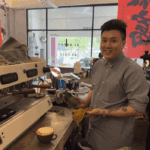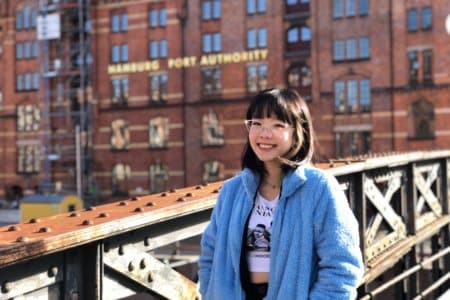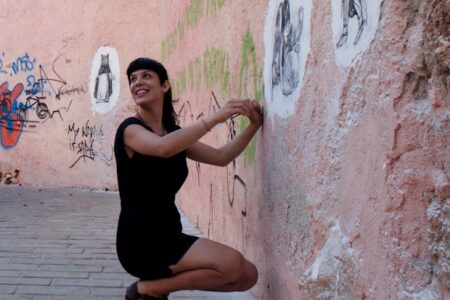
Unlike many Asian parents, Belinda Zhang’s mum and dad support her passion for art. Or, as she says, they didn’t have a choice.
She’s been doing art since she was two years old and never wanted to do anything else. For her parents, the message was clear: accept your daughter as an artist or risk losing her. They chose the first and in a twist of fate, Zhang is now the one making them proud in a distinctly Asian way: getting into what’s arguably the best university in the world for art.
Belinda Zhang can’t pinpoint the beginning of her interest in art — it’s just always been part of her life.
Born in Singapore, Zhang was only 1 years old when she moved to Hong Kong, where she lived for 12 years or so before moving back to Singapore.
Now at 21, she finds herself away from her home country once again as a painting major at Rhode Island School of Design (RISD).
Laser-focused on her dream school
For many a young artist, studying at the RISD is the big dream.
Located in Providence, Rhode Island, RISD is one of the world’s most prestigious art schools, and even dubbed by some as the Ivy League of Art Schools. With a 13.8% acceptance rate, it’s a daunting university for some to even attempt applying to.
But Zhang did, due to rather “shallow reasons” at first.
“I had set my mind on RISD and RISD only since 2016 or so,” Zhang says. “I remember first seeing vlogs of RISD students on YouTube, and as you know, I had been doing art my whole life and never even considered pursuing anything else. So seeing hints of the campus, classrooms, and later on finding out its prestige and ranking, only further convinced me that this was the perfect choice for pursuing a visual arts degree.”
Having that vision from a young age gave Zhang ample time to prepare her art portfolio. By late 2018, when she was in the eighth grade, she began making works with the goal of them being good enough to be included in her portfolio.
While she didn’t use many of those pieces in her final portfolio, it was good practice and taught her more about composition, concept, material, and other elements.
With the guidance of teachers as well as information posted online, Zhang made sure to include variety in her portfolio, balancing more technical pieces like realistic or anatomical works with more conceptual, creative, and experimental pieces. Like those who inspired her, Zhang has shared her portfolio, which was accepted by numerous well-known art schools, on YouTube.

Zhang is studying fine arts at RISD, majoring in painting. Source: Belinda Zhang
Tempted into fine arts
Zhang didn’t always think she would be studying fine arts at RISD, though. For a long time, she thought she’d major in illustration, until a talk with her high school A-level art teacher “tempted” her to consider fine arts.
Her freshman drawing teaching assistant further solidified her decision just a month or so before she had to declare her major.
“I’m sure anyone in the arts has been told at least once that doing fine arts makes you no money, and to go for something corporate, commercial, or industrial if you really have to pursue art (or design) of all things,” she says.
Given that mindset, she thought illustration would be the best “compromise.” It could be applied to corporate jobs, but it would still allow her to preserve some elements of fine arts-making.
“Fine arts, like painting, always felt like an unrealistic career, but that A-level teacher said that he believed I had the potential, and that majoring in illustration wasn’t necessarily going to make anything easier,” she points out.
Both her teacher as well as the teaching assistant had gone through the same dilemma when they were freshmen, but realised that art degrees are more versatile than what people think. The majority of alumni end up doing something outside of their college major, anyway.
To some, that may sound depressing. After all, it implies that your education might not actually shape your career path.
But Zhang found it reassuring. To her, it meant that declaring a major wouldn’t fully close the doors to other options.
“I think that’s also the thing I’m thankful I found out about before going into a major as a ‘compromise,’ and something that might be helpful to other arts students,” Zhang says.

Zhang’s artwork, titled Breath and Bone (Burial). Source: Belinda Zhang
A hopeless career path?
“A hopeless career path.” “You won’t have a stable job.” “You’ll be taken over by AI.”
These are some of the most common misconceptions Zhang has heard about her degree.
But what field isn’t? Every other field is thought to be overly saturated nowadays, with industry giants culling jobs and replacing workers with AI.
“With the current economic status of the world, it’s been kind of funny hearing people still specifically talk down on art, because the other industries aren’t exactly looking much brighter these days,” Zhang says.
That said, she understands that fine art isn’t for the faint of heart. It’s a hard path to take, but Zhang strongly disagrees with anyone who thinks it’s not essential to society. She believes that art has always been one of the key pillars defining and upholding a society’s culture and tradition. More than that, it is required in almost every other field.
“Designers, architects, and marketers all require some sort of fine arts knowledge and training behind their work. I’d argue that a fine arts degree is all the more versatile since the skills you learn can be applied to various roles and industries,” she says.

Zhang’s “The Three Witches” painting. Source: Belinda Zhang










